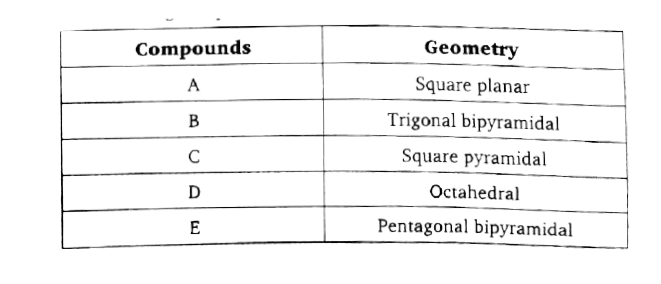Calculate value of X+Y+Z10, here X is O-N-O bond angle in NO−3 Y is O-N-O bond angle in NO+2 and Z is F-Xe-F adjacent bond angle in XeF4.
The correct Answer is:39
X=120(sp2 hybridization)
Y=180 (sp -hybridization)
Z=90(sp3d2 hybridization)
120+180+9010=39010=39
Topper's Solved these Questions
- CHEMICAL BONDING (BASIC)BOOK - VK JAISWAL ENGLISHCHAPTER - CHEMICAL BONDING (BASIC)EXERCISE - ASSERTION-REASON TYPE QUESTIONS
23 Videos
- CHEMICAL BONDING (ADVANCED)BOOK - VK JAISWAL ENGLISHCHAPTER - CHEMICAL BONDING (ADVANCED)EXERCISE - SUBJECTIVE PROBLEMS
48 Videos
- CO-ORDINATION COMPOUNDSBOOK - VK JAISWAL ENGLISHCHAPTER - CO-ORDINATION COMPOUNDSEXERCISE - SUBJECTIVE PROBLEMS
42 Videos
Similar Questions
Assertion : Multiple bond between two bonded atoms can have more than three bonds.
Reason : Multiple bond between two bonded atoms can not have more than two π-bonds.
View SolutionThere are two groups of compounds A and B. Groups A contains three compounds Px4,Qy3,Rz2. Groups B also contains three compounds Sx4,Ty3,Uz2. Hybridization of each central atom of group A compounds is same as that of iodine in IBrCl− while in group B compounds it is same as that of iodine IBrCl+. Substituents X, Y and Z exhibit covalency of one in ground state. Then find the value of x/y.
Where, x and y are total number of lone pair present at central atoms of compounds of group A and B respectively.
View SolutionConsider the following compounds with their regular geometries.

Calculate value of (x+y−z)2, where x is total number of axial d-orbitals having zero nodal plane, y and z are total no. of non-axial and axial d-orbitals respectively each one having two nodal planes used in hybridisation of central atoms of compounds A to E.
View SolutionThe N-O bond in NO−2 is shorter than N-O bond in NO−3. Account for this observation.
View SolutionCalculate value of (X+Y+Z)/(10) , here X is O-N-O bond angle in NO_(3)^(-) Y is O-N-O bond angle in NO_(2)^(+) and Z is F-Xe-F adjacent bond angle in XeF_(4) .
View SolutionThe N-O bond in NO_(2)^(-) is shorter than N-O bond in NO_(3)^(-) . Account for this observation.
View SolutionThe increasing order of O-N-O bond angle in the species NO2,NO+2andNO−2 is-
View SolutionThe O−N−O bond angle in the nitrite ion, NO−2, is closest to :
View SolutionThe O-N-O bond angles in the nitrate ion, NO_(3)^(-) are best described as being :
View SolutionThe O−N−O bond angle in the nitrite ion, NO−2, is closest to :
View SolutionCalculate value of (X+Y+Z)/(10) , here X is O-N-O bond angle in NO_(3)^(-) Y is O-N-O bond angle in NO_(2)^(+) and Z is F-Xe-F adjacent bond angle in XeF_(4) .
View SolutionThe correct order of N-O bond length in No, NO−2 and NO−3 will be
View SolutionFind the sum of X, Y and Z, here X is O-N-O bond angle in NO−3, Y is O-N-O bond angle in NO+2 and Z is F-Xe-F adjacent bond angle in XeF4.
View SolutionThe increasing order of O-N-O bond angle in the species NO2,NO+2andNO−2 is
View SolutionO−N−O bond angle is maximum in :
View SolutionThe O−N−O bond angle in the nitrite ion, NO−2, is closest to :
View Solution

